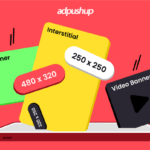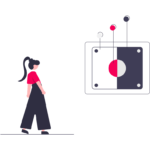As fast as the digital advertising industry is growing, it needs to be governed by specific standards so that the multitude of parties can work together in harmony – a job done by the Interactive Advertising Bureau (IAB). For context, it is a governing body for the AdTech industry responsible for its standardization and smooth functioning.
IAB standard ads sizes play an important role in easing the buying/selling process of the ad inventory within the AdTech ecosystem. From time to time, it keeps on bringing new standardizations to keep up with the industry trends.
In this blog post, we will talk about IAB standard ads units and the new IAB standard ads unit portfolio released in 2017.
What Are IAB Standard Ads?
An IAB standard ad size can be defined as an ad unit that is seen on most websites. Currently, three sizes are considered standard ads:
- Leaderboard (728×90)
- Medium rectangle (300×250)
- Skyscraper (160×600)
These ad units are used extensively in the ad tech industry and are considered the most profitable ad sizes. Publishers can implement these ads easily; their demand is always high from advertisers, and they help increase the earning potential of publishers.
It should be noted that IAB’s ad portfolio also recognizes several other ad sizes, including billboard (970×250), smartphone banner (300×50, 320×50), and portrait (300×600). However, the ad sizes mentioned earlier are used the most in the digital advertising industry.
Publishers should ideally experiment with different ad sizes to see which ones give them the highest returns. Moreover, using different ad sizes can also help them deal with banner blindness, which is a problem that arises while leveraging popular or common ad sizes.
IAB New Ad Portfolio
The IAB Tech Lab developed guidelines that define the New Ad Portfolio. These standards of ad size focus on enhancing the advertising experience across multiple platforms, including mobile apps, websites, and social media.
The New Ad Portfolio also focuses on ‘new media experiences’ such as virtual and augmented reality ads.
At present, user intent and privacy are the prime reasons for most changes occurring in the ad tech industry.
The emergence of privacy laws such as GDPR and CPRA and the demise of third-party cookies are heavily focused on protecting users from fraud. Thus, the organization has placed user privacy at the core of its new IAB standard ads portfolio.
- Since the user’s key aim is to consume website content, advertisements should not be disruptive.
- User experience is of high priority and can be enhanced by giving users control over the kind of advertising experience they want. For example, providing clear close buttons on the creatives can be an excellent way to put the user in charge.
- Better user experience also means that ads should render as fast as possible on a website, which is why IAB’s New Ad Portfolio also focuses on faster load performance.
Note: “The IAB New Ad Portfolio replaces all the previous creative display guidelines for mobile and desktop – including the Universal Ad Package (UAP), rich media units, and other ad units’ related guidance.”
The focal point of the transition to a new standard is making digital advertising lightweight, flexible, cross-screen ads that follow LEAN principle. Let’s break it down:
1. Flexible Ads
A major feature of new ad units, as described in the IAB Standard Ads Unit Portfolio, is that they are based on aspect ratio as opposed to the previously followed norm of fixed pixel sizes.
These days, users are actively using multiple devices to browse. Furthermore, screen sizes vary for similar devices as well. Due to this, advertisements need to adapt to different devices and screen sizes. This is why flexible ad units are essential.
A flexible ad unit will ensure that ads are delivered properly across different screen sizes and can be integrated with responsive website designs. Flexible ad units basically maintain their aspect ratio and adjust according to the screen size.
In addition to ensuring that the original sanctity of creatives is maintained to provide good page experience across multiple devices to users, flexible ad units also enhance operational efficiency for publishers.
Flexible Size Ad Specifications
The flexible size ad specifications are driven by the landscape of consumer devices, publisher operational efficiency, and creative fidelity requirements.
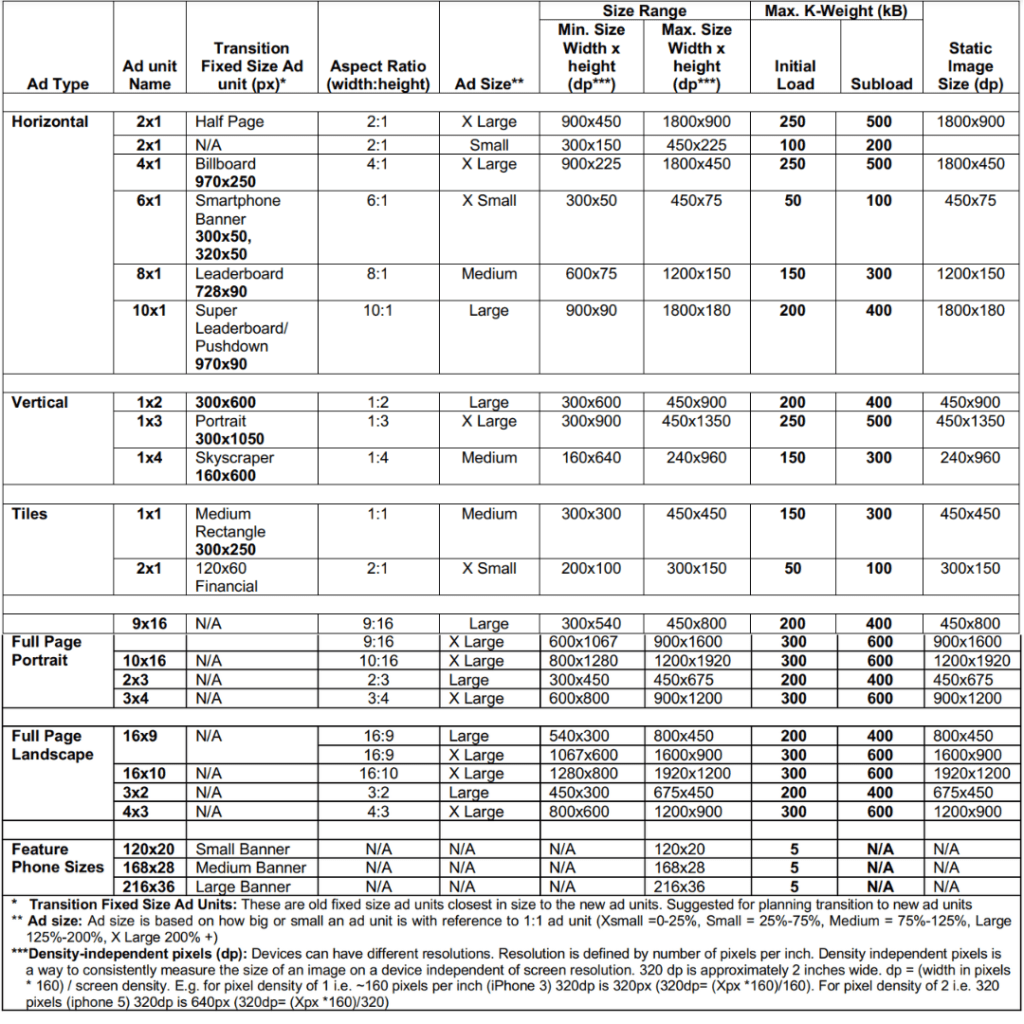
Source: IAB (PDF)
Let’s get to know these ad types in detail:
- Horizontal: This is one of the most versatile ad types, with ad units ranging from X small to X large. Under horizontal ads, the ad units include half-page, billboard, smartphone banner, leaderboard, and super leaderboard/pushdown. The initial load for this ad type ranges between 50-250 kB.
- Vertical: These ads are mainly placed on the right or left flank of the web page and include half-page, portrait, and skyscraper. The size ranges from medium to X large, with the initial load ranging from 150-250 kB.
- Tiles: These ad types are used for display ads like sticky ads and docked ads and include medium rectangle and financial, coming in two sizes – medium and X small, respectively. The initial load for a medium rectangle ad is 150 kB, and 50 kB is for financials.
- Full-page portrait: This type of ad has around five sizes under its turf, either large or X large. Advertisers use these ads for high-intensity campaigns as they fully grab a user’s attention, increasing their viewability manifold. Its initial load is between 200-300 kB.
- Full-page landscape: Just like full-page portraits, these are also used in high-intensity ad campaigns. The sizes vary between large and X large, and the initial load is similar to a full-page portrait.
- Feature phone sizes: It has three banner sizes – small, medium, and large.
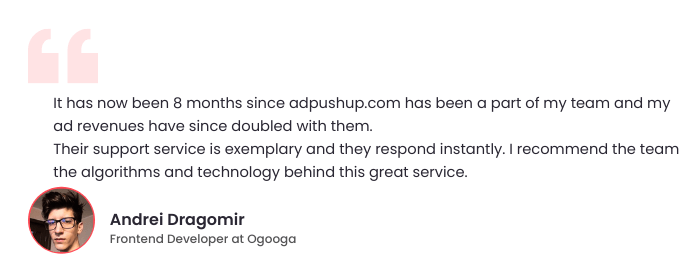
2. LEAN Ads
Other than flexible ads, the new IAB standards also emphasize LEAN ads. LEAN stands for Light, Encrypted, AdChoices supported, and Non-invasive.
As we mentioned, the IAB New Standard Ad Unit Portfolio prioritizes user experience by ensuring that users have control over what they consume and how long they consume and respect their choices.
This is essentially done by serving users with LEAN ads. For example, lightweight ads will ensure that page latency is minimized and ads are rendered quickly. Similarly, non-disruptive ads will ensure the user can consume the main website content without hindrance.
Publishers can go through the IAB Standard Ads Unit Portfolio to better understand Flexible and LEAN ad specifications.
IAB Guidelines for Display and Mobile
There are certain guidelines established by the IAB to guide publishers on limitations on file sizes and serving ads in HTML5. The main aim of these guidelines is to make the buying/selling process more efficient and enhance the user experience.
- Initial load is the load of the ad that is delivered to a browser when a HTML file is called. The initial load is limited to 150kb, but can reach 200kb, depending on the ad partner. The limit of file requests for each initial load has been set at 15 so that the page performance doesn’t get affected.
- IAB suggests a max 30% CPU load per active ad for the ads to perform without disrupting site performance.
- IAB recommends ad servers and publishers to improve the ad load performance by using shared libraries & browser caching in HTML5 ads.
- The file request for initial file load is 10 for host-initiated file requests.
IAB Standard Sizes for Ads
While browsing the vast expanse of the internet, you’ll notice that the most common ad formats are the Leaderboard, the medium rectangle, and the skyscraper. These ad sizes have become staples on web pages and serve their purpose effectively.
Common IAB Ad Formats
Let’s understand in depth the three standard sizes:
- Leaderboard (728×90): Also called horizontal ad banner, it is one of the most popular ad sizes among the advertisers. It is rectangular in shape and is mainly placed at the header or footer in a webpage.
- Medium rectangle (300×250): Slightly square in size, it is one of the widely used ad formats since 2017, when Google published guidelines for placing ads above the fold. This ad size is widely used by publishers who monetize their website using display ads.
- Skyscraper (160×600): These ad units, being vertical in size, offer one of the highest viewability and are in constant demand among the advertisers. Hence, these ads units also offer a higher profit margin compared to other sizes.
However, the New Ad Portfolio brings more ad sizes. In addition to the usual suspects, it introduces a variety of other ad sizes, such as the smartphone banner, available in both 300×50 and 320×50 dimensions, and the expansive billboard measuring 970×250.
Let’s look at other ad sizes in detail:
- Smartphone banner (300×50 or 320×50): It is the most common ad size for mobile advertising used by app developers. Generally seen above or below the app content, it is commonly used in gaming applications.
- Expansive billboard (970×250): It is an expandable ad format that covers more than half of the screen when a user clicks on it. Expansive billboard ads are known for their attention-grabbing features and giving an immersive brand experience to the user.
Now that many options are available, publishers should consider stepping beyond their comfort zones and experimenting with different ad sizes. This diversification can be the key to unlocking higher returns and engaging audiences in fresh and innovative ways.
One significant advantage of using various ad sizes is their potential to combat the looming threat of banner blindness. This occurs when internet users become so accustomed to the standard ad sizes that they subconsciously filter them out, rendering them less effective over time.
By incorporating a mix of ad sizes, publishers can grab the attention of their target audience and keep them engaged, effectively countering banner blindness.
What are the Benefits of the IAB Standard?
1. Streamlined Ad Inventory Creation
IAB standards simplify the process of creating ad inventory. By providing clear guidelines and specifications, they ensure that ad units can be developed and deployed more efficiently.
2. Responsive Ad Sizing
The IAB New Ad Portfolio approach adopts sizes based on aspect ratio rather than fixed pixel dimensions. This flexibility allows ad units to adapt and display consistently across a wide range of devices, including smartphones, tablets, and desktops. This responsive design ensures that the ads maintain their visual integrity, regardless of the screen size.
3. Guidance for Emerging Technologies
IAB extends its influence beyond traditional advertising, offering guidelines for publishers venturing into new technologies such as social media, augmented reality, virtual reality, and even emoji-based advertisements. This support and expertise can be invaluable for publishers exploring innovative and engaging ad formats.
4. Improved User Experience
Next, the new ad portfolio places a strong emphasis on faster loading performance. Speedy ad rendering not only benefits publishers by reducing bounce rates but also enhances the overall user experience. Users are more likely to engage with content that loads quickly, leading to increased ad effectiveness and viewer satisfaction.
5. Optimized Earnings
For publishers seeking to monetize their websites through ad networks like Google AdSense, adhering to IAB standards can significantly boost their display ad earnings. These standards are designed to maximize the compatibility and effectiveness of ads across various platforms, increasing the likelihood of higher click-through rates and conversions.
About IAB and IAB Tech Lab
IAB was founded in 1996 and has now become a leading association in the interactive advertising field. Over 650 media and technology enterprises are members of this association. IAB majorly creates standards and guidelines for the advertising industry. Other than this, the association also focuses on conducting research in the field of interactive advertising and educating the people working in the advertising industry.
It should be noted that IAB ‘recommends’ publishers, advertisers, and other parties in the advertising industry to follow the standards and practices that they create, however, it is not a mandatory requirement. But since the leading companies in the advertising industry are members of the IAB, publishers will certainly benefit if they are working in conjunction with the IAB recommended practices and guidelines.
What Are IAB Standards?
IAB standards are guidelines and best practices set by the Interactive Advertising Bureau that act as a handbook for publishers and advertisers for technical directives. These guidelines help standardize the advertising process to maintain uniformity in the advertising world.
IAB Tech Lab
IAB Tech Lab is an international association that is responsible for developing technical standards for the advertising industry. This is to ensure that the multiple parties that are part of the supply chain are able to work together in harmony. Additionally, if the majority of participants in the advertising industry adhere to standards developed by IAB tech lab, the industry can witness consistent growth.
IAB Tech Lab has brought many innovations, standards, and products, such as brand safety, consumer privacy, ad experiences, and programmatic experiences.
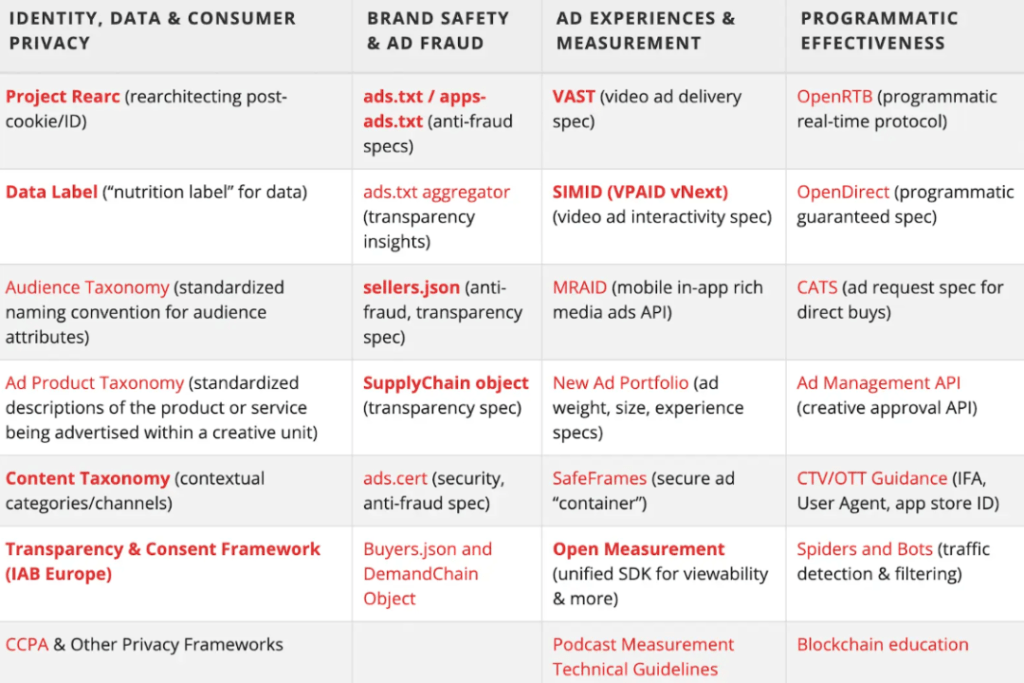
Source: IAB Tech Lab
Final Thoughts
While publishers do not have to follow the IAB standard ad size specifications as a rule, it is definitely the ideal way forward in the digital advertising landscape. If web designers would have to create different ad sizes for different websites, the situation would become highly chaotic.
Furthermore, publishers’ ad revenue can take a serious hit if they are not adhering to IAB standards. Therefore, in order to stay relevant in the industry and make good profits, publishers should stick to ad units that are used universally.
Frequently Asked Questions
The common IAB Standard Sizes are 300×250 medium rectangle, 180×150 rectangle, 160×600 wide skyscraper, and 728×90 leaderboard.
IAB ad units are used extensively in the ad tech industry and are considered the most profitable ad sizes. Publishers can implement these ads easily, their demand is always high from the advertisers, and they help in increasing the earning potential of publishers.
Some of the best-performing banner ad sizes are as follow:
300×250 – Medium rectangle
336×280 – Large rectangle
728×90 – Leaderboard
320×50 – Mobile leaderboard
IAB stands for Interactive Advertising Bureau, an AdTech regulatory body that sets standardized guidelines for the advertising industry.


